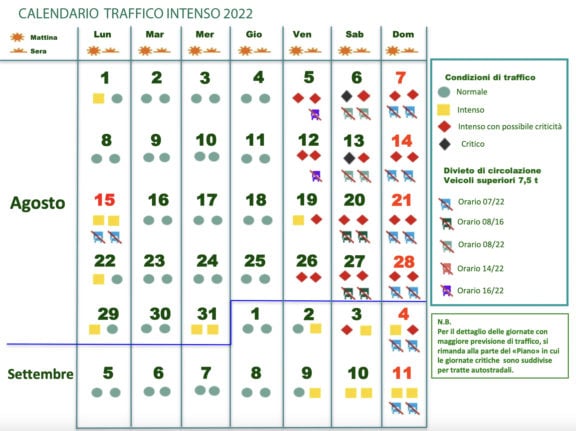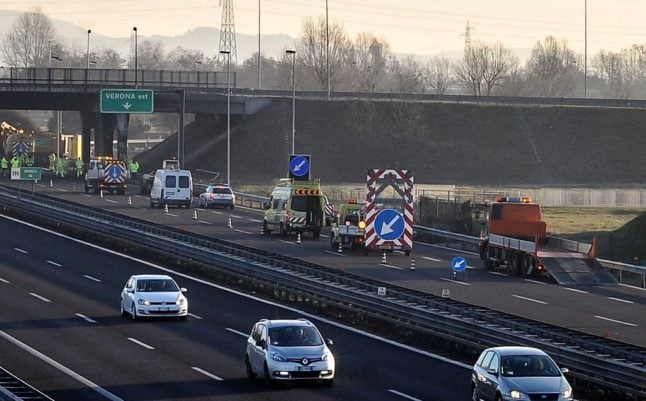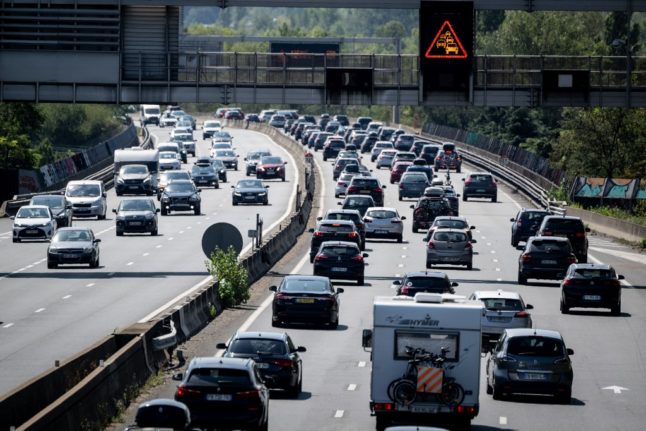Italy’s autostrade, or motorways, rarely see much in the way of heavy traffic during the cold season. But that all changes in summer, especially in August, when hundreds of thousands of Italians take to the road to reach their chosen holiday destinations.
The Ferragosto weekend is generally the worst time of year to travel on Italian roads, and the latest road traffic forecasts show this year is no exception.
READ ALSO: The worst dates to travel on Italy’s roads this August
The official road traffic calendar released by the Italian State Police (Polizia di Stato) offers a good overview of which days are likely to see the worst congestion.
The calendar is colour-coded, with a ‘yellow’ spot indicating heavy traffic, ‘red’ indicating heavy traffic with ‘possible critical conditions’, and ‘black’ indicating ‘critical’ traffic.

As the table shows, Friday, Saturday and Sunday are all expected to be marked by very intense or critical traffic, with congestion worst on Saturday morning.
The situation should improve on Monday, August 15th, the day of Ferragosto, though traffic on most Italian roads is expected to still be fairly heavy throughout the day.
READ ALSO: Ferragosto: Why the long August holidays are untouchable for Italians
Naturally, the best way to avoid getting stuck in traffic over the weekend (and consequently rediscovering your appreciation for Italian swear words) would be to travel outside of the above-mentioned days, that is either before or after them.
Should that not be possible, here’s a breakdown of the roads that are more likely to register nightmarish levels of traffic this weekend, according to Italian media reports. This might help you plan alternative routes or reschedule your departure times accordingly.
Motorways (Autostrade)
- Motorway junctions RA13 and RA14 near Trieste, Friuli Venezia-Giulia
- Motorway A14, connecting Bologna (Emilia-Romagna) to Taranto (Puglia)
- Motorway A1, connecting Milan to Naples
- Motorway A2, commonly known as the ‘Mediterranean Motorway’ (Autostrada del Mediterraneo), connecting Salerno (Campania) to Reggio Calabria (Calabria)
- Motorway A30, connecting Caserta to Salerno (Campania)
- Motorways A19 (Palermo-Catania) and A29 (Palermo-Mazara del Vallo) in Sicily
State Roads (Statali)
- State Road 16, known as ‘Statale Adriatica’, going from Padua, Veneto to Otranto, Puglia
- State Road 309, known as ‘Strada Romea’, connecting Venice to Ravenna, Emilia-Romagna
- State Road 36, stretching from Sesto San Giovanni, Lombardy to Italy’s border with Switzerland (Passo dello Spluga)
- State Road 18, commonly known as ‘Tirrenia Inferiore’ connecting Naples to Reggio Calabria
- State Road 106, commonly known as ‘Statale Jonica’, stretching from Reggio Calabria to Taranto (Puglia)
- State Road 148, known as ‘Statale Pontina’, stretching from Rome to Terracina and
- State Road 7, known as ‘Statale Appia’, going from Rome to Brindisi (Puglia)
- State Road 1, known as ‘Via Aurelia’, connecting Rome to Ventimiglia, Liguria
- State Roads 675 (from Terni, Umbria to Monte Romano, Latium) and 3-bis (from Terni to Ravenna, Emilia-Romagna)
- State Road 131, known as ‘Statale Carlo Felice’, connecting Cagliari to Porto Torres (Sardinia)
Unsurprisingly, the roads that tend to be busier over the Ferragosto weekend are those leading to popular tourist destinations, especially those located near the seaside.
READ ALSO: MAP: Which parts of Italy will get the most tourism this summer?
If you were planning on using one of the above-mentioned roads to reach your holiday destination, you may want to consider drawing up an alternative route.

Further information
The Italian State Police offers guidance on alternative itineraries at the following online links:
The following resources will keep you up to date with the latest developments on the roads:
This online map from Italy’s motorway construction and maintenance company ANAS features live updates on road closures, maintenance work, traffic levels and even weather conditions. The service is also available through their mobile app, ‘VAI’.
Motorway company Autostrade per l’Italia offers a similar live map, showing road closures and traffic jams as well as the locations of the nearest petrol stations and service areas.
The Italian Transport and Infrastructure Ministry’s Twitter account gives live updates on the status of the country’s major roads.
If you want to speak directly to an operator while you’re on the road, you can do so by either contacting ANAS’s customer service at 800 841 148 or using their live chat.



 Please whitelist us to continue reading.
Please whitelist us to continue reading.
Member comments